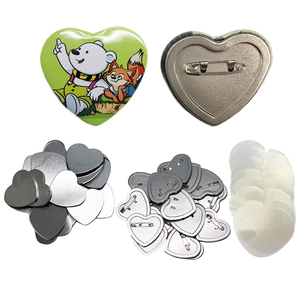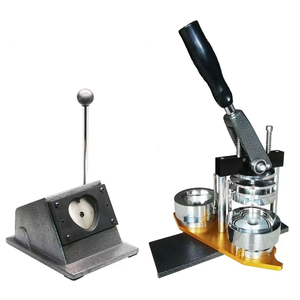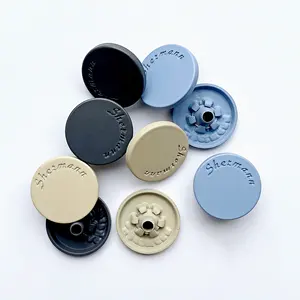
All categories
Featured selections
Trade Assurance
Buyer Central
Help Center
Get the app
Become a supplier

(12018 products available)




















































Zhejiang Yiwu button are decorative fasteners utilized in clothing and other textile products. They are produced in diverse shapes, sizes, and materials, thus serving both practical and aesthetic functions. Here's a look at the various types of buttons:
Plastic Buttons
Plastic buttons are versatile and widely used due to their durability and cost-effectiveness. They can mimic the appearance of other materials, such as wood or metal, and are available in numerous colors and shapes. Plastic buttons are ideal for everyday clothing because they withstand wear and tear.
Metal Buttons
Metal buttons are associated with elegance and strength. They are crafted from materials like brass, stainless steel, or aluminum, thus providing a robust and stylish fastening. These buttons are often used in denim apparel, coats, and formal wear because of their durability and aesthetic appeal.
Wooden Buttons
Wooden buttons add a natural and rustic touch to garments. They are lightweight and come in different finishes and grains, providing a unique look to each button. Wooden buttons are frequently used in eco-friendly clothing and crafts, offering a distinctive and organic aesthetic.
Fabric Covered Buttons
Fabric-covered buttons are created by wrapping a button base with fabric, thus allowing for a match with the garment's material. These buttons can be customized to suit any fabric and are typically used in formal wear, upholstery, and accessories for a seamless look.
Glass Buttons
Glass buttons are exquisite and often adorned with intricate designs or patterns. They are heavy and provide a vintage or antique look to garments. Glass buttons are commonly used in specialty and vintage clothing, adding a touch of nostalgia and elegance.
Horn and Shell Buttons
Horn and shell buttons offer a luxurious and natural option. They are carved from natural materials, thus providing unique textures and colors for each button. These buttons are sustainable and eco-friendly, making them ideal for high-end and environmentally conscious clothing.
Snap Buttons
Snap buttons, also known as press studs or snaps, provide a quick and easy fastening solution. They are used in place of traditional buttons and are ideal for children’s clothing, outerwear, and casual apparel due to their simplicity and efficiency.
Shank Buttons
Shank buttons have a protruding loop or shank on their back, making them easy to sew onto thick fabrics like coats and knitwear. Their design prevents the button from pulling the fabric, thus ensuring a secure and comfortable fastening.
Toggle Buttons
Toggle buttons are secured with a loop of fabric or cord instead of being sewn directly onto the fabric. They are popular in outerwear and casual clothing for their ease of use and adjustable nature.
The buttons are available in various designs. Some of the common design elements include:
Material
Zhejiang Yiwu button factory make buttons using various materials. Each material offers unique benefits. Plastic buttons are popular for their versatility and cost-effectiveness. They can mimic other materials like wood or metal. Metal buttons, including those made from zinc alloy, are valued for their durability and aesthetic appeal. They often feature intricate designs and are used in garments that require a sturdy fastening. Fabric-covered buttons blend seamlessly with the garment's fabric. They provide a cohesive look and are often found in custom or tailored clothing. Mother-of-pearl buttons offer a touch of elegance. They are lightweight and have a natural iridescence.
Shape and Size
Yiwu button manufacturers produce buttons in various shapes. Each shape serves different functional and aesthetic purposes. Round buttons are the most common. They offer a classic and versatile option for various garments. Square buttons provide a modern and geometric alternative. They are often used in casual or contemporary clothing. Oval buttons offer a sleek, elongated look. They fit well in narrower spaces and add a distinctive touch. Specialty shapes like heart, star, or novelty shapes are used for decorative purposes. They add a playful element to clothing. The size of the button can significantly impact the overall design of a garment. Large buttons make a bold statement. Small buttons offer a subtle and delicate appearance.
Color and Finish
Buttons come in various colors. These colors can be solid, transparent, or gradient. The color choice can complement or contrast the garment's fabric. This adds depth and visual interest. Transparent buttons blend seamlessly with the fabric. They allow the underlying material to show through subtly. Gradient buttons transition smoothly between colors. They create a dynamic and eye-catching effect. The finish of a button, whether matte, glossy, or textured, further enhances its visual appeal. Matte finishes provide a modern and understated look. Glossy finishes add shine and vibrancy. Textured finishes like embossing or engraving create tactile and visual interest.
Decoration and Embellishments
Many buttons feature decorative elements that enhance their aesthetic appeal. These include buttons with intricate patterns or designs. These are often stamped or engraved onto the button's surface. Additionally, buttons adorned with gemstones or crystals add a touch of luxury and elegance to garments. Some buttons may also have embroidered patterns or fabric coverings that offer a customized look. These decorative elements transform buttons into focal points on clothing. This elevates the overall design of a garment.
These are some ideas for wearing and matching buttons:
Q1: What materials are commonly used to make buttons in Yiwu?
A1: Yiwu button factories utilize various materials, including plastic, metal, wood, and fabric-covered buttons. Plastic buttons are popular for their versatility and cost-effectiveness. Metal buttons, such as zinc alloy and stainless steel buttons, are favored for their durability and aesthetic appeal. Wooden buttons offer a natural and unique look, while fabric-covered buttons provide a wide range of textures and patterns.
Q2: Can Yiwu button factories produce custom button designs?
A2: Yes, Yiwu button factories offer custom button manufacturing services. Clients can collaborate with designers to create unique button designs that meet their specific requirements. This includes selecting materials, sizes, shapes, and finishes. The factories utilize advanced technology, such as CNC machining and 3D printing, to produce prototypes and mass-produce custom buttons.
Q3: What are the quality assurance measures in Yiwu button factories?
A3: Yiwu button factories implement stringent quality assurance measures to ensure consistent product quality. This includes using automated inspection systems to check for defects and adherence to specifications. Quality control teams conduct regular audits and tests on raw materials and finished products. The factories also comply with international quality standards and certifications.
Q4: What is the production capacity of Yiwu button factories?
A4: Yiwu button factories have a high production capacity, capable of manufacturing millions of buttons per day. Their automated production lines and skilled workforce enable them to meet large orders promptly. The production capacity may vary depending on the button type and order size.
Q5: How do Yiwu button factories handle environmental concerns?
A5: Yiwu button factories prioritize sustainability by implementing eco-friendly practices. This includes using recyclable materials and reducing waste in the production process. The factories also comply with environmental regulations and standards to minimize their ecological footprint.